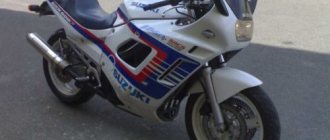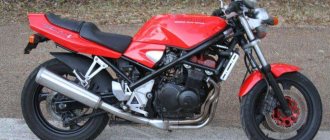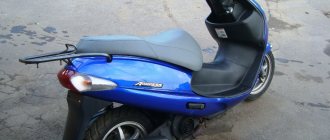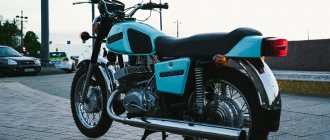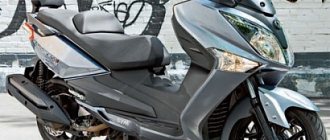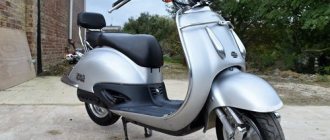Review of Suzuki Burgman 650 (2003)
I have been interested in motorcycles for a long time, a hobby, so to speak. While still at school I got a moped, then a second one, then Izh, Java and away we go...
Before buying the Suzuki Burgman AN650, I owned a Chinese knock-off SkymotoBravo 260, externally copied from the Suzuki Burgman 250 of the mid-2000s and a 260cc engine copied from the Yamaha Majesty 250. The device is interesting, quite comfortable, but... Chinese. I had to go through it immediately after purchase, because it could crumble along the road. I got pretty tired of experiencing the miracle of the Chinese motorcycle industry, and after reaching a mileage of 7,000 km, the Bravo was successfully sold to the “happy” owner, who is still bringing it to mind.
The difficult everyday life of choice has arrived. I wanted something particularly powerful, but in the form factor of a maxi-scooter. Why a scooter? Yes, there are several reasons for this: a comfortable fit, a high windshield that protects from rain, stones and insects, protection of the legs from water and dirt, a lot of space under the seat (helmets, clothes), a bunch of glove compartments, an automatic transmission.
The choice was between the Honda Silver Wing 600 and the Suzuki Burgman AN650. There is another wonderful device - Gilera GP 800, but it is expensive, and since it was produced quite recently, it is almost impossible to find it in Ukraine. There is also a Yamaha T-MAX 500, but it looks more like a motorcycle, less powerful and I don’t like the look at all. In general, the device is good, but not for everyone.
My soul was drawn more to Burgman. The scales have tipped in Suzuki's favor due to the electronically controlled variable speed automatic transmission (SECVT) with the ability to manually change gears and the “Power” mode. I also liked the Burgman better in appearance and the rumors about better efficiency did their job. It was decided to look for the Suzuki Burgman AN650. And he was found. Imported from Italy with 20,000 miles (although I don’t really believe it), with scratches on the glass of the instrument panel, a crack on the sides and other minor flaws.
The characteristics of the device are as follows: Working volume: 638 cm3; Engine type: 4-stroke, liquid cooled, DOHC, 2-cylinder with injection; Power: 55 hp at 7000 rpm; Torque: 62 Nm at 5000 rpm; Acceleration to 100 km/h (standard mode): 6.5 seconds; Acceleration to 100 km/h (power mode): 5.5 seconds; Fuel consumption: 3.7/5.1/7.0 l./100 km.; Maximum speed: 180 km/h.
The first trip made me squeal with pleasure! The Burg accelerated simply at lightning speed, and with the “Power” mode turned on, you generally had to hold on tightly to the steering wheel. Many motorists, thinking that this was an ordinary scooter, tried to accelerate and overtake, but then realized that it was in vain. It is extremely difficult to compete with this “moped”. But as it turned out, the dimensions and weight do not make it easy to maneuver in the city crowd, as the Chinese 260 allowed. And with rapid acceleration, the Suzuki becomes completely uncontrollable for some time, so it is advisable to do this only at a straight distance. Braking from high speeds also did not please me with the same loss of control over handling, although it is easy to dose the braking force. Another disadvantage for tall drivers is that the legs begin to rest against the front panel, and this is with the lumbar support pushed back as far as possible! Terrible discomfort. There are too many switches installed on the left handle of the steering wheel (turns, switching lights, switching speeds, “Power” mode, manual mode, signal) and all this without illumination in the dark! At night, no, no, and you’ll press something wrong. Lots of questions about plastic. It's frankly cheap and flimsy, sometimes it seems like it's Chinese. There are many shortcomings: the fuse cover falls off, the front glove compartment does not close tightly, the fasteners for the rear plastic under the stop fall off, etc. There is also no outside temperature indicator, like in Yamahas. In a car of this class for $15,000, this is unforgivable!
There are several congenital diseases. For example, tractor-diesel rumble at idle speed of vehicles manufactured before 2005. Some people like it, but it bothers me. Quite often, wear of a set of plastic gears of the variator servo drive occurs. This happens due to the wear of the torque drive keys among those who like to “ignite”. In models after 2005, this misunderstanding was corrected. Oil leaks from under the pump are common. Treated by replacing the rubber o-ring. The short service life of the front and rear wheel bearings in models manufactured before 2005 is disappointing. The fact is that the bearings in the wheels were installed closed only on the outside, and over time dirt and water got into them, which sharply reduced their service life. It can be treated by installing bearings that are sealed on both sides.
Why am I all about the minuses! After all, there are a lot of advantages! The power and torque of the engine make you forget about the disadvantages. Excellent SECVT automatic transmission in manual mode paired with an excellent two-cylinder engine allows you to achieve maximum efficiency and dynamic acceleration even from 40 km/h in fifth gear. And in automatic mode, it will always switch to a lower gear when overtaking or sharp acceleration, which the variator of the same HondaSilverWing 600 cannot do. Therefore, the consumption is not so great: on the highway together at 120-130 a maximum of 5.5 l/100 (and one no more than 100 at all 4.5) and at the same time uses 92 without problems. The same Honda in this mode eats a liter and a half more. The comfortable fit allows you to cover long distances without any problems. One of the trips this year was 1100 km in a day and, surprisingly, was not completely exhausting. There was fatigue, but not critical. And distances of 500-600 km per day are generally achieved in one breath. The head light deserves special praise. Conventional halogen lamps satisfy all requirements and xenon is out of the question. And this despite the fact that in the European version only one headlight shines on high beams. But in Japanese modifications under the name SkyWay, two headlights shine on high beams, although not in the right place, because there is left-hand traffic... The huge trunk under the seat (which is opened with the key in the ignition) allows you to place two full-size helmets and a bunch of other personal belongings. And if you also install a trunk, as I did, the total volume of the luggage compartments becomes simply huge! Tents, clothes, mattresses, food, a lot of clothes - everything is drowning in the abyss of luggage compartments. But there are two more small glove compartments in the front, one of which can easily fit a half-liter bottle and one large glove compartment in the middle. I am pleased with the good visibility back into the large “burdock” mirrors. Yes, and they fold, which is convenient in the parking lot or if you need to squeeze between cars. Models after 2005 already have an electric servo for folding mirrors. I am glad that there is a 12V outlet, although it is not in a very convenient place.
Yamaha WR450F 2022
Although the WR450F has long had a reputation as a serious and angry motorcycle, Yamaha is not one to rest on its laurels. Just two years after a major update to the WR, the Blues have given it all the same upgrades that their flagship YZ450F received in 2022. Accordingly, the 2022 WR450F and 2020-2021 YZ450F share many components, but the enduro model also has some features developed specifically for it - including ECU settings, muffler, suspension settings and engine mounts.
Yamaha WR450F engine
The new Yamaha WR450F cylinder head, camshafts, piston and connecting rod are identical to those found on the latest generation YZ450F motocross bike. The transmission is five-speed, but its widely spaced gears differ from cross-country gears. It is also worth noting the strengthened stator of the generator, the maximum power of which has been increased from 120 to 140 watts, necessary for bright headlights and fast charging of the battery.
The ECU settings and exhaust system are designed specifically for the Yamaha WR450F. This means that the WR is equipped with a multi-chamber muffler with a mechanical spark arrester and an ECU that is locked from modifications. For those who are interested in this model as a racing model, an optional ECU from the GYTR catalog is available, as well as a communication unit (CCU), necessary for editing engine maps using the Yamaha Power Tuner application on a smartphone, including for adjustment to a tuning exhaust, be it either a slip-on or a full exhaust tract. The GYTR ECU is equipped with two base maps and allows you to mount a steering wheel map switch to change them on the fly.
Yamaha WR450F
Even with the limitations of the ECU and exhaust, the Yamaha WR450F engine performs great—no wonder, given that it is essentially a YZ450F race engine. It starts faster than previous versions, whether in neutral or in gear. Compared to the cross version, it is somewhat less powerful, but it works smoothly and smoothly. It responds well to the throttle and has a little more pronounced engine braking than usual. The reduction in power compared to the YZ450F even has a number of serious advantages in some situations, in particular, when riding at low and medium speeds, you don’t have to worry about losing traction when using the gas sharply. Of course, when driving at high speeds, breaking a wheel by sharply jerking the gas is as easy as shelling pears.
How widely spaced the gears are is especially noticeable between first and second. The first is surprisingly low, which is very good for enduro - be it quiet rides through wild places, or the back-end trails of some difficult route. You can easily get going with the second one, and the third one is quite enough for a single track. On the fourth and fifth, the motorcycle seems to lose its stupor and flexes its eyebrows in a bad way: right now, they say, let’s burn. In stock the stars are 13:50, so there is room to play around in both directions. By installing a 48-tooth rear or a 14-tooth forward, you can get a faster WR for those who are not particularly threatened by plug trails.
Yamaha WR450F suspension
The Yamaha WR450F is equipped with the same components as the motocross flagship: KYB Speed Sensitive System (SSS) 48-spring forks and a monoshock from the same brand. However, the internal components (valves and springs) of both suspensions have been selected specifically for enduro. The WR450F fork has 4.6Nm springs (versus 5.0Nm on the YZ450F), and the rear shock is equipped with a 56Nm spring (versus 58 on the YZF).
Accordingly, the suspensions are noticeably softer than those on the YZ450F and YZ450FX, but not too soft - they provide excellent controlled support, allow them to be folded quite deep without overly harsh rebound, and the overall bike feels more solid than sprung. Suspension adjustments are simple, predictable and tangible.
By releasing the front and rear rebound by two clicks, I livened up the chassis a bit, adding comfort on rocks and a light feel. The suspension is well balanced, the fork only occasionally folds a little more, giving a barely noticeable dive.
Yamaha WR450F
Yamaha WR450F Chassis and Handling
The current version of the Yamaha WR450F is based on the latest generation YZ450F chassis. Among the differences of the new frame is a reduction in the thickness of the upper frame beam by 0.5 mm and an increase in the thickness of the pipe wall in the engine mounting area by 0.5 mm, while the frame geometry remains the same. The upper crossmember has become thinner to reduce rigidity and make the motorcycle lighter. The front axle was also lightened, while simultaneously becoming 20% stiffer.
The riding position of the Yamaha WR450F is no different from the YZ450F, even though the WR tank is 2.5 liters larger. This can be attributed to the inverted engine-in-frame layout, which allowed designers to extend the tank downwards rather than making it wider or taller. The characteristic feeling of sitting on a Yamaha arises partly from the characteristic bend of the steering wheel, and partly from the seat, located at a fairly comfortable height, but a little wide compared to Austrian motorcycles.
Tall riders will appreciate the ability to adjust the position of the Yamaha WR450F handlebar: spacers can be installed in the near or far holes and turned forward or backward. These four options provide a handlebar adjustment range of 36.5mm. Another nice feature for tall people is the presence of an optional high seat in the GYTR catalog.
The front brake of the Yamaha WR450F received a new caliper with larger pistons - from 22.7 to 25.4 mm in diameter. The brake pads also increased by 22.3 percent, and the contact area with the front disc pads increased by 16%. Surprisingly, the rear brake remains the same despite the YZ450FX being equipped with a new caliper and disc.
On the move, you clearly feel the kinship of the WR450F with the YZ450F - the enduro model is only a little softer in terms of response and suspension, but otherwise is very similar to a motocross motorcycle. The 7-odd kilogram difference in weight is noticeable, but it doesn’t become a problem at all. Moreover, the WR grips the ground more tenaciously, and this is its big advantage.
Reviews of Yamaha Majesty Rating: 3.6 out of 5 4 reviews found
22.05.2012
Brief background: I drove the SilverWing600 for two years (review on the same site). Then I rode a ZZR-1200 for two years (to understand what a normal motorcycle is). Then I got tired of sweating in my gear, and I went back to the maxi-scooter. And since the main disadvantage of Silver for me was its heavy weight, I chose from the 400 cc ones. Now I’m very happy with my Majesty400, finally I have a normal weight (like 197 kg), now I can roll the scooter backwards naked without getting off it. I can stand next to him, holding him with one hand and lighting a cigarette with the other. It’s much easier to drag it onto the center stand (which you have to do often, because when wound up on the side it doesn’t want to stand), etc. Although on the first trip, I realized that it was much more sensitive to the dividing strips (the other side of the weight coin), but I quickly got used to it and now I don’t notice it anymore. Normal maneuverability in traffic jams appeared (and with it the dislike for these traffic jams went away). The fact that the cutouts for placing your feet on the asphalt are smaller than on Silver, now I know that this is not a minus, because if you put your feet too close, you can easily not hold it (especially with a passenger). In general, I’m finally 100% satisfied with the weight. My Majesty is much more comfortable than MY Silver (although on the Internet they often call Silver comfortable, and Majesty sporty-rigid, so this question remains a mystery to me). With dynamics: that’s all in comparison, I expected it to be a little worse than 600cc, but in fact the Majesty is just a vegetable. The normal acceleration limit, as I thought, has moved from 160 to 140 km/h, which is not critical (then you need to fire it up). But the dynamics are not just a little worse, they are many times worse! If on the Silver you need to work with the gas headlong, then on the Majesty you can safely unscrew the throttle all the way, even from a standstill, even while moving (you won’t be able to scare the passenger with acceleration). Frankly, I expected more from the 400cc. It’s difficult to find reliable data on acceleration, so I drove from zero to 100 with a car that accelerates in about 12 seconds, and I couldn’t overtake it. By the way, with the passenger, Silver’s dynamics were only slightly worse, and the Majesty dies already at 120-130 km/h (then you need to stoker), I didn’t have the patience or the road to accelerate to the maximum speed. But he alone showed a not bad maximum speed of 165 km/h (it doesn’t want to go further, although the speed is in the red zone, I didn’t feel the cutoff. Either it’s very smooth, or it’s just not enough hp to accelerate further). There is an idea that it is so “non-dynamic” due to the settings of the variator. Consumption really comes out to 4-4.5 liters versus 7 liters on Silver. My cruising speed is 120-130 km/h. No, on a flat road you can safely accelerate at least to the maximum, it’s not particularly blown away by the wind, there doesn’t seem to be any extraneous noise, but I noticed a problem with mine: if at a speed of more than 130 km/h you hit a large bump (of which we have plenty), then the scooter compression of the suspension enters into some amplitude oscillations left and right. At this speed, such swaying really scares me. Technically, when checking the scooter, I did not find any faults. You could safely drive the Silver up to 160 km/h without straining yourself during most overtaking sessions. On the Majesty my riding style has become calmer. On an empty road it’s 120-130, on a perfectly flat road at least to the maximum, but if there are cars, then I drive in the traffic, almost without overtaking. Although there are enough speakers to keep in the flow and there is even a reserve for unexpected accelerations. Although the mirrors are small, so far not a single car has hidden from me in the dead zone. The brakes are not good, because... they are not combined. You have to constantly use two handles at the same time; the incorrect scooter weight distribution simply does not allow you to brake with one. Although the information content is of a wave order, from 100 km/h I hold the brake once and stop exactly in front of the traffic light, without adjusting the force on the brake handle. I can’t say anything about overheating and the effectiveness of emergency deceleration from high speed, because... I don’t drive this car too dynamically. About vibration: on (again, MY) Silver there was an unpleasant small vibration. For example, if you slightly relax your left hand at a speed of 100 km/h, the left mirror begins to vibrate. It always irritated me. Conclusion: I no longer consider the two-cylinder in-line engine a plus. On the Majesty there is only a large single-cylinder vibration, which irritates me a little only when I am standing at a traffic light. The wind protection suits me quite well (by the way, on Silver there was a problem; with increasing speed, air began to get into some part of the helmet, creating a very unpleasant noise, this It was tiring at long distances, but Majesty is okay with that). My hands are covered with plastic (although you can’t tell from the outside), but at +2 degrees I didn’t freeze them. Well, let’s move on to the minuses. The rear passenger seating position is terrible! In chopper style, legs forward, the entire weight of the body presses on the spine. I have the optional small backrest, which at least somehow helps me avoid losing a passenger. The footrests are also very uncomfortable. By the way, on the Silver there is only one minus for the passenger - you had to climb very high up there, but the comfort is super. I don’t want anyone to find themselves in the role of a passenger on the Majesty, and even more so over long distances. I have a problem with biting my leg. If (for example, in a traffic jam) you crawl by stomping (stepping) your feet, then in the process of slightly tilting the scooter to the side, your foot (especially the left one) gets between the variator casing and the asphalt. It’s scary, the scooter is moving forward by inertia. After all, I know about this, but still, from time to time, my foot gets there. That’s probably where the disadvantages end. And again about consumption. The tank is 14 liters (16 on the Silver), but thanks to much lower consumption, it is now quite enough for me. And I hate electronic fuel level indicators, but again, because of such consumption, I finally became friends with it. On the Silver, due to the consumption and the harsh suspension, along the way I often had the thought that I should have driven a car. Now I don’t have such thoughts, I drive calmly, enjoying myself, I’m not in a hurry, traffic jams are no longer a problem. So, given my experience of going through a completely normal motorcycle and returning to a maxi-scooter, I can say that I have found my ideal “Maxika”. I feel very sorry for those people for whom the ultimate dream is Burgman650 (or something like that). Remember, the more powerful, the heavier. But this is not always necessary and not for everyone. P.S. Filters are really expensive, 4+ thousand each. rub. per set from the dealer, and judging by the condition, they will have to be changed 2 times a year. I wonder if my statements are shared by people who rode SilverWing600 and Majesty400? And then suddenly it was only I who came across the hard and vibrating Silver, and the soft and undynamic Majesty...
